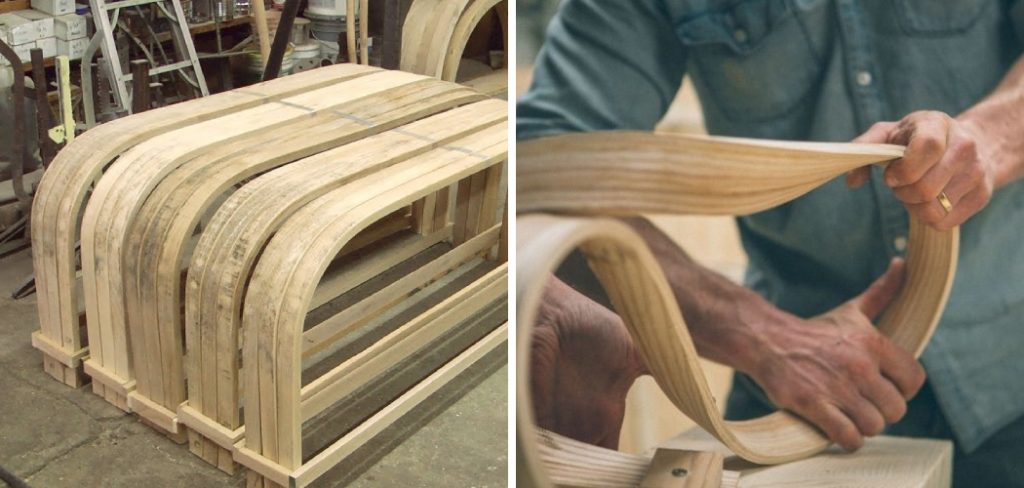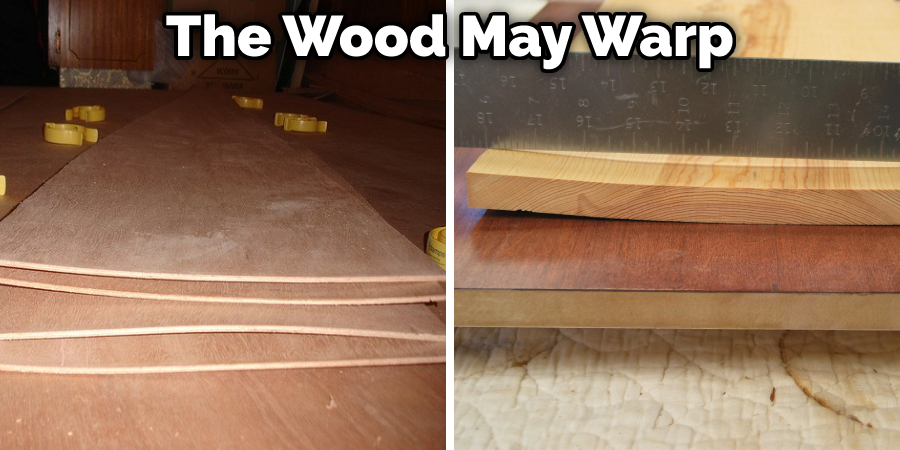As a hobbyist woodworker, you may have tried bending wood with steam or heat. But did you know that you can also bend wood with water? In this blog post, we will show you how to bend wood with water using a few simple steps. Keep reading to learn more!

What is Water Bending?
Water bending, also known as “stream bending,” is a technique that involves using water to make wood more pliable and easier to bend. This method has been used for centuries by woodworkers and furniture makers to create intricate designs and shapes in their projects. It is a simple and effective way to bend wood without the need for expensive equipment or chemicals. It is also a great way to repurpose scrap wood and create unique pieces.
Why Should You Bend Wood with Water?
There are many reasons why you might want to bend wood. Perhaps you’re looking to create a new piece of furniture, or you’re trying to add some decorative touches to your home. Whatever the reason, water can be an effective tool for bending wood.
When wood is soaked in water, the fibers swell and become pliable. As a result, it’s much easier to bend the wood into the desired shape. In addition, water helps prevent the wood from cracking as it dries. As long as you take care not to over-soak the wood, bending it with water can be an easy and effective way to achieve your desired results.
Things You’ll Need
Water:
The first thing you’ll need is, of course, water. You can use tap water or distilled water – just make sure it’s clean and free of impurities.
Stock Pot:
You will also need a large stock pot to soak the wood in. Make sure it’s big enough to fit the pieces of wood you want to bend.
Wood:
You can use any type of wood for water bending, but some species are more suitable than others. Hardwoods like oak, ash, and maple are great choices because they have tighter and stronger fibers that can withstand the bending process.
Clamps:
To hold the wood in place while it dries, you will need a set of clamps. Make sure they are sturdy and can withstand the pressure of bending wood. You can also use straps or ropes if you don’t have clamps.
How to Bend Wood with Water 11 Step-by-Step Guide
Step 1: Choose a Suitable Wood for Bending
The best woods for bending are pliable and have a high moisture content. Softer woods such as pine, spruce, Douglas fir, and cedar are good choices. Hardwoods such as oak and maple can be more difficult to bend.
The wood should also be free from knots, cracks, and other defects. These can cause weak spots in the wood and make it more likely to break during the bending process.
Step 2: Check the Wood’s Moisture Content:
To get started, you’ll need to check the moisture content of your wood. If the wood is too dry, it won’t bend. If it’s too wet, it will warp and possibly crack. The ideal moisture content for bending wood is 18% and 22%. You can check the moisture content of your wood with a moisture meter.

You can also estimate the moisture content by weighing the wood before and after soaking. If the weight increases by 10%, then the wood has reached its ideal moisture level.
Step 3: Find a Waterproof Container
A waterproof container is essential for this project. You’ll need to be able to submerge your wood in water, so a regular bowl or bucket won’t work. A clear plastic storage bin works well, or you can use a clean, empty fish tank.
It’s important to note that the container should be large enough to fit your wood pieces without bending them. You also want to make sure it can hold enough water to fully submerge the wood.
Step 4: Submerge the Wood in Water and Let It Soak
After you’ve cut your wood to the desired length and thickness, it’s time to bend it. First, you’ll need to submerge the wood in water and let it soak for at least 30 minutes. This will help to soften the wood and make it more pliable.
The longer you let the wood soak, the more pliable it will become. However, be careful not to over-soak the wood as this can cause it to lose its strength and integrity.
Step 5: Create a Bending Form with A Smooth Edge
Use either a C-clamp or a hand screw to secure the wood to your work surface. Ensure that the clamps are not positioned too close to the area you will be bending, as this could cause the wood to break. If you’re using a hand screw, it’s best to have someone help you hold the wood in place while you’re screwing it down.
The bending form should have a smooth edge against which the wood can bend. You can use a piece of metal or a wooden dowel for this purpose.
Step 6: Bend and Clamp the Soaked Wood to The Mold
Once the wood is securely in place, you can bend it. Slowly and carefully bend the wood until it’s in the desired shape. Then, clamps were used to secure the wood to the mold. Make sure the clamps are tight enough to hold the wood in place but not too tight that they damage the wood.
You can use multiple clamps and place them at even intervals along the length of the wood for more support.
Step 7: Allow the Wood to Dry
Once you have bent the wood to the desired shape, it is important to allow it to dry completely. Otherwise, the wood may warp or crack as it dries. Next, you can place the wood on a flat surface or hang it up to dry. If you are in a hurry, you can use a hairdryer to speed up the process.

Once the wood is dry, you can sand it down to create a smooth finish. You can also apply a clear sealant to protect the wood from moisture and wear.
Step 8: Remove the Wood from the Mold
After the wood is completely dry and has been shaped, you can carefully remove it from the mold. Be gentle to avoid damaging the wood. If the wood is still slightly damp, let it air dry a bit more before removing it.
If the wood has not taken on the desired shape, you can repeat the process of soaking and bending until you achieve your desired results.
Step 9: Sand and Finish
Once the wood is removed from the mold, sand it down to create a smooth finish. You can also apply a sealant or varnish to protect the wood and enhance its natural beauty. Although this step is optional, it can help to prevent the wood from cracking or warping in the future.
You can also paint or stain the wood to match your project’s aesthetic. It’s all up to your personal preference and the intended use of the wood.
Step 10: Enjoy Your New Wood Project
Congratulations, you have successfully bent wood with water! Now, you can admire your new piece of furniture or decorative item and showcase your woodworking skills. Thoroughly clean and dry your tools before storing them away for future use.
It’s important to note that while this method is effective for bending wood, it may not produce perfect results every time. Wood is a natural material and can be unpredictable at times. So, don’t be discouraged if your first attempt doesn’t turn out as expected.
Step 11: Experiment with Different Shapes and Designs
Now that you know how to bend wood with water, you can experiment with different shapes and designs. Let your creativity run wild and see what unique pieces you can create using this simple yet effective technique.
Following these steps and taking the time to perfect your technique will help you become a pro at bending wood with water. Keep practicing, and soon you’ll be able to take on more complex projects with confidence.
Other Ways to Bending Wood with Water Using a Steam Box
1. Select a Suitable Wood
The first step is to select a suitable wood for the job. Waterbending works best with hardwoods that have a tight grain. Softer woods, such as pine, will not work as well.
2. Check the Wood’s Initial Moisture Content
Use a moisture meter to check the wood’s initial moisture content. If the wood is too dry, it will be difficult to bend. It may warp or crack as it dries if the wood is too wet.
3. Buy or Build a Steam Box
A steam box is a chamber in which wood is subjected to steam until it becomes soft and flexible. You can purchase a steam box or build one yourself. If you choose to build a steam box, make sure that it is made of a heat-resistant material such as plywood and has proper ventilation to allow the escape of steam.
4. Steam the Solid Lumber
Once your steam box is set up, place the solid lumber inside and close the lid. Apply heat to the chamber and wait for it to fill with steam. The amount of time you will need to steam the wood will depend on its thickness. Thinner pieces of wood will only need to be steamed for 15-20 minutes, while thicker pieces may need to be steamed for 30 minutes or more.
5. Create a Mold with A Smooth Edge
The wood should now be soft and pliable. You will need to create a mold with a smooth edge to shape it. This can be done by bending the wood around a form or template or clamping it.
6. Clamp the Steamed Wood to The Mold
Once the wood is bent into the desired shape, clamps are used to hold it. Ensure that the clamps are evenly distributed so that the wood dries evenly and does not warp.
7. Allow the Wood to Dry
Allow the wood to dry in the mold for 24-48 hours. After it has dried, you can remove it from the mold and sand it smooth.

8. Finish the Wood
Once the wood is dry and smooth, you can finish it with a sealer or stain. Be sure to follow the manufacturer’s instructions for the best results.
Now that you know how to bend wood with water, you can easily create curved pieces of wood for your projects. With a little bit of practice, you will be able to create beautiful curved pieces that will add a unique touch to your projects.
Can You Bend Wood with Boiling Water?
If you’re looking for a way to add a bit of curve to your woodworking projects, you may be tempted to try boiling water. After all, it’s a simple and inexpensive method, and it doesn’t require any special equipment. But does it work?
The short answer is yes. Boiling water can indeed cause wood to bend. But it’s important to keep in mind that this method is not suitable for all types of wood or applications. Generally speaking, boiling water is only effective on small pieces of wood that are not under a lot of stress.
In addition, the process is irreversible, so you need to be very careful when using this method. If you’re not sure whether boiling water will suit your project, it’s always best to consult with a professional.
Can You Bend Wood with Cold Water?
You can bend wood with cold water, but it’s not as effective as hot water. Hot water makes the cellulose in the wood more pliable, which allows you to shape it more easily. Coldwater will still cause the cellulose to expand, but not as much as hot water.
You can still use cold water to bend wood if you don’t have access to hot water. Soak the wood in a tub of cold water for several hours or overnight if possible.
Then, take the wood out and shape it as desired. You may need to apply some pressure to get it to bend, but it should be pliable enough to work with. Keep reading for more information about how to bend wood with water.
Additional Tips:
- Always Wear Protective Gear, Such as Gloves and Safety Glasses, When Working With Wood.
- It’s Important to Use Dry Wood for Water Bending. Wet or Green Wood Will Not Work Well and May Result in Cracking or Warping.
- Experiment With Different Types of Wood to See Which Works Best for Your Project.
- If Your Wood Starts to Dry Out During the Shaping Process, You Can Re-steam It to Make It Pliable Again.
- Don’t Rush the Process. Take Your Time and Allow the Wood to Dry Completely in the Mold Before Removing It.
- Practice Makes Perfect! Don’t Be Discouraged if Your First Few Attempts Don’t Turn Out as Expected. Keep Practicing and Honing Your Skills.
- Consult With a Professional if You’re Unsure About the Best Method for Bending Wood for Your Specific Project.
By following these tips and techniques, you can create beautiful and unique pieces of curved wood for your woodworking projects. Whether you choose to use hot or cold water, the key is to take your time and perfect your technique. Happy bending!
Frequently Asked Question
Does Soaking Wood Make It Easier to Bend?
There is some debate on whether soaking wood before bending it makes the process easier. Some people say that it does, while others maintain that it doesn’t make a difference. Experiment with both methods and see which works better for you.
How Long Do You Soak Wood in Water to Bend It?
The length of time you soak the wood in water will depend on how much you want to bend it. Soaking it for 30 minutes should do the trick for a small amount of bending. Soaking it for a few hours may be necessary for more severe bends.
Can You Bend Wood without Steam?
There are a few ways that you can bend wood without steam. One way is to use a heat gun. You can also use a clothes iron. Another way is to use a vacuum cleaner. Finally, you can also use a hairdryer.
What Wood Is Easiest to Bend?
There are a few types of wood that are easier to bend than others. The best types of wood to use for bending are willow, elm, and lime. These woods have a high moisture content, making them easier to bend.

Conclusion
Wood is a versatile and renewable resource, making it an appealing choice for many DIY projects. By learning how to bend wood with water, you can create curved shapes and structures that wouldn’t be possible with traditional methods.
With a little practice, you can use this technique to add beautiful and unique details to your next project. Have you tried bending wood with water? What challenges did you encounter? Share your experience in the comments below!
You Can Check It Out To Split Large Logs with A Wedge
You May Also Read: How to Split Wood With a Maul

